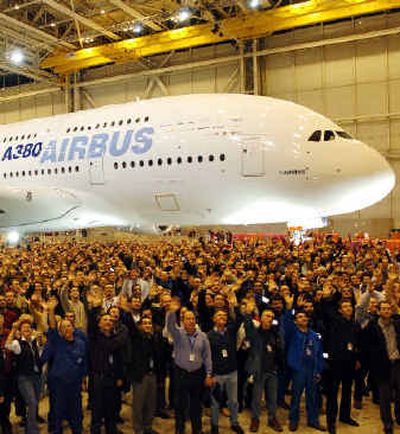Airbus’ big gamble

TOULOUSE, France — Airbus put its stamp on aviation history Tuesday, unveiling the world’s largest commercial jet and raising the stakes in its 35-year rivalry with Boeing Co.
The double-decker A380 “superjumbo,” capable of flying up to 800 passengers, gives the European plane maker a new flagship and completes its range of jets at a time when Boeing is losing market share and reducing some production.
French President Jacques Chirac and other European leaders struck a triumphal note at the ceremony, hailing the A380 as a sign of Europe’s capacity to generate world-beating industries.
“It’s a symbol of economic strength, technological innovation, the dedication of the work force that built it and above all of a confidence that we can compete and win in the global market,” British Prime Minister Tony Blair said.
But the A380, which was partially funded by European governments, amounts to a huge bet that carriers need ever-bigger planes to process a growing numbers of passengers through the busiest hub airports. Airbus is investing $13 billion to develop the plane, which has a list price of $280 million apiece. Test flights should begin by March 31, but commercial passengers won’t be able to buy tickets until sometime next year.
If Airbus is right, the A380 could consign the once-dominant Boeing 747 jumbo jet to history, deal a further blow to the Chicago-based company and leave Airbus with a monopoly in a lucrative and fast-growing market. Boeing would need 10 years or more to develop a rival to the A380, industry experts say.
But if its sales forecasts prove to be too optimistic or the new plane’s production costs soar, then the Airbus lead over Boeing in plane deliveries over the past two years could disappear.
The new Airbus plane has a connection to Spokane: the Triumph Group Inc. plant here said last week it has landed a $35 million contract to manufacture floor panels for the freighter version of the plane. That factory was a Boeing plant until Boeing sold it two years ago.
Boeing sees a different future for itself, one in which industry deregulation and smaller, long-range planes like its planned two-aisle 7E7 Dreamliner allow passengers increasingly to fly direct, spurning stopovers. The 7E7, which will seat between 217 and 289 passengers, is scheduled to debut in 2008.
But Boeing is hedging its bets. Last year, it announced plans for a larger, 450-seat 747, despite having previously dismissed the need — and Airbus’ plans — for a bigger plane. A launch decision is expected in mid-2005.
New orders for the current 747 are on the decline, dropping from 35 in 1999 to 10 in 2004. Boeing delivered 15 last year and its current backlog is down to only 32, according to the company. It has no orders for the aircraft so far this year.
“Clearly, we will not get back to the glory days of large manufacturing production rates” for the 747, said Boeing spokesman Todd Blecher. But he added, “We’re quite happy with where the 747 fits in the market, today and going forward.”
Jon Ash, president of InterVISTAS-ga2, a Washington-based aviation consulting firm, also said he sees a future for the Boeing plane. “The 747 is going to have the middle market, for those carriers that don’t believe they can generate the kinds of volumes that are necessary for the A380, or where their route structure is not constrained by congestion,” he said.
Airbus already has 149 orders for the A380, which has a 262-foot wingspan and a tail as tall as a seven-story building. It says it needs 100 more to break even, and a further 500 before it can deliver on its pledge of a 20 percent return on investment.
In a three-class cabin layout, the A380 will carry 555 passengers — 33 percent more than the 747. On a full tank, it will carry passengers 5 percent farther than Boeing’s longest-range jumbo, Airbus claims, at a per-passenger cost up to one-fifth below its rival’s.
Airlines, which have closely guarded their A380 cabin designs, will decide how to use the extra space. Low-cost carriers could operate a single economy-class layout accommodating as many as 800 passengers. In contrast, Virgin Group Chairman Richard Branson said his airline, which has ordered six A380s, will offer private double beds for first-class passengers.
CEO Chew Choon Seng said Singapore Airlines will begin using the plane for service to London and Sydney when it becomes the first carrier to carry commercial passengers aboard the A380 in mid-2006.
Fred Smith, CEO of FedEx Corp., which has ordered 10 of the A380’s freighter version, said the plane and its 165-ton payload would have “very far-reaching effects on the efficiency of world trade” and boost FedEx’s network between the United States, Asia and Europe. Rival United Parcel Service Inc. has ordered 10 superjumbos.
Airbus’ announcement follows a decision last week by the United States and European Union to try to amicably resolve a long running dispute over government subsidies for the world’s two biggest aircraft makers. Both sides committed to stopping the subsidies for three months while talks continue.
The weak dollar is another potential factor. Most of Airbus’ costs are in euros, and the plane maker said last week it has been forced to raise its dollar-denominated prices to cope.
Lehman Brothers analyst Joseph Campbell predicted in a report that the dollar’s slide, combined with a U.S. airline recovery, would halt Boeing’s loss of market share.